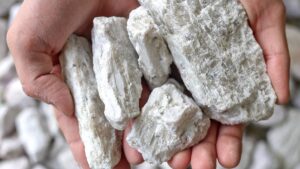It’s lithium, but cheaper, and easier – here’s why these ASX explorers are putting their money on the brine

Picture: Getty Images
It’s not your usual kettle of fish, yet production from brine ponds are some of the most lucrative commodity extraction operations in the world – and there are plenty of googly-eyed ASX miners plying their trade in South America.
Generally quantified as large-scale and low-grade, lithium brine is measured in parts per million (ppm) – or milligrams per litre if you will – quite a differential from the grading of hard rock sources known as spodumene, which grades in percentages per tonne and has different refinement requirements.
Currently, the world’s brine production is centred around what’s known as the ‘Lithium Triangle’, characterised by natural deposits of lithium called ‘salars’, found underneath the expansive salt flats of the borders between Argentina, Bolivia, and Chile, which purportedly account for about 60-70% of global lithium reserves.
Unconventional, yet highly profitable
Brine production is seen as more lucrative, less intensive and produces fewer emissions; however, these types of projects can require more intensive planning and development strategies to get off the ground as opposed to hard rock projects which have the luxury of borrowing development and processing ideologies from other commodities such as precious and base metals.
Speaking to Stockhead, Galan Lithium (ASX:GLN) non-exec director Daniel Jimenez Schuster says that while extracting lithium from brine is worth the legwork, companies need to understand the unconventional nuances of the mining processes right from the get-go.
“The major constraints for developing brine operations lie in being able to bring together a team with the right kind of expertise to understand the hydrogeological aspects of lithium brine extraction,” Jimenez Schuster says.
“With brines it can be very complicated, while you know what you are getting in any static moment, you extract it and the pond will infill from what’s around it, so it requires careful planning, management and control of the brine chemistry to optimise the lithium grades while minimising the co-extraction of unwanted impurities.
“Each well will be subject to climactic and geological change over time and needs to be analysed and refreshed as you don’t necessarily have the same composition you had before because they are brought up from different depths.
“To give you an example, SQM operates ~160 wells, yet there are no more than about ~40-50 operational at any given moment.”
Initially pegged to start producing 50,000tpa of lithium carbonate from its Kachi project in 2024, Lake Resources (ASX:LKE) has learnt this the hard way.
It recently announced that development costs are set to potentially double to US$1.5bn and it would have to split the project into two 25,000tpa production stages, the first not into production until 2027.
For its part, Galan seems acutely aware of these challenges on its road to production.
Jimenez Schuster – who worked with SQM for three decades – thoroughly reviewed Galan’s vision for its Hombre Muerto West and Candelas projects before joining in 2019 and has been instrumental to the process to-date.
“The key to success is in the planning. There are very few specialists available that understand what the limitations are, what the risks are, where to drill and how to design, build and optimise the ponds.”
Who else is out fishing for brine?
There are a bunch of other Australian explorers making headway into the lithium-rich salars.
In Chile, SQM and Albemarle’s Salar de Atacama is the country’s biggest producer, while Aussie junior Lithium Power International (ASX:LPI) is concentrating on the nearby Maricunga project.
Bolivia is also blessed with a huge endowment of lithium – some say upwards of 21Mt – yet political tensions, corruption, infrastructure and underwhelming local base knowledge for mining brine are hindering progress in its enormous Salar de Uyuni precinct.
On the radar in Argentina is Galan, which is making major steps towards the construction of the country’s next major lithium brine operation, recently receiving development permits for the first stage of its Hombre Muerto West project signalling ‘all systems go’ for its team on the ground.
Phase 1 of HMW will see the developer produce 4,000t of lithium chloride concentrate, with a DFS just around the corner to bolster the economic case for the staged start-up.
A larger Phase 2 DFS is expected in August or September this year, which lays out a runway for Galan to ramp up output to 20,000t of lithium carbonate equivalent a year. By 2030, its phased mine plan will see a production rate of 60,000tpa.
“While we develop and execute construction plans, our next step is to negotiate agreements to convert our product into lithium carbonate,” Jimenez said.
While Galan is waiting for approval for an export licence, it is also weighing up options to refine its LiCl into lithium carbonate in-country, as Argentina will have about nine conversion plants online by 2025.
“Lithium chloride concentrate is not something new and the challenges need to be recognised. We are gifted with people in our team that have decades of experience in brine production and we look forward to developing HMW and Candelas into a world-class lithium project,” Jimenez Schuster said.
“We’ve done our due diligence, the hard work starts now.”
Lithium Energy (ASX:LEL) is currently proving up resources at its Solaroz project – next door to Allkem’s Olaroz – having recently encountered massive intersections of lithium-rich brines up to 473.5m thick and lithium concentrations of up to 555mg/l. A maiden JORC resource estimate from Solaroz is imminent.
Then there’s Patagonia Lithium (ASX:PL3) – freshly minted to the ASX at the end of March this year with an $8.6m IPO – looking at direct lithium extraction (DLE) technology for its Formentera project, recently pulling up assays that showed up to 1,122ppm of lithium.
Meanwhile, Argosy Minerals (ASX:AGY) is also setting up shop in Argentina at its Rincon lithium project where it’s already testing and producing from its 2,000tpa lithium facility that will soon ramp up to 10,000tpa.
AGY is proving up more resources to extend mine life and future production capacity with diamond drilling ongoing and also negotiating offtake agreements.
There’s also Pursuit Minerals (ASX:PUR), a junior explorer which is also looking to make waves into Argentina’s Salta precinct.
It’s recently started surveying its tenements to determine drill targets at its Rio Grande Sur project to confirm where to strike based on historically proven, shallow lithologies.
It’s also acquired a pilot plant to test its LCE production to gather further evidence of the viability of its resources.
As a penny stock, this is definitely one to watch.
While Galan Lithium and Lithium Energy are Stockhead advertisers, they did not sponsor this article.
Related Topics

UNLOCK INSIGHTS
Discover the untold stories of emerging ASX stocks.
Daily news and expert analysis, it's free to subscribe.
By proceeding, you confirm you understand that we handle personal information in accordance with our Privacy Policy.








